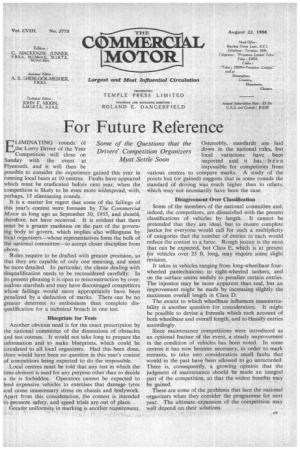For Future Reference
Page 43

If you've noticed an error in this article please click here to report it so we can fix it.
ELIMINATING rounds of the Lorry Driver of the Year Competition will close on Sunday with the event at Plymouth, and it will then be possible to consider the experience gained this year in running local heats at 10 centres, Faults have appeared which must be eradicated before next year, when the• competition is likely to be even more widespread, with, perhaps, 15 eliminating rounds.
It is a matter for regret that some of the failings of this year's contest were foreseen by The Commercial. Motor as long ago as September 30, 1955, and should, therefore, not have occurred.. It is evident that there must be a greater readiness on the part of the governing body to govern, which implies also willingness by local organizers—whose representatives form the bulk of the national committee—to accept closer discipline from above.
Rules require to be drafted with greater precision, so that they are capable of only one meaning, and must be more detailed. In particular, the clause dealing with disqualification needs to be reconsidered carefully. In its present phrasing it is open to misconstruction by overzealous marshals and may have discouraged competitors whose failings would more appropriately have been penalized by a deduction of marks. There can be no greater deterrent •to enthusiasm than complete disqualification for a technical breach in one test.
Blueprints for Tests Another obvious need is for the exact prescription by the national committee of the dimensions of obstacles and test courses. It would not take long to prepare the information and to make blueprints, which could be circulated to all local organizers. Had this been done, there would have been no question in this year's contest of competitors being expected to do the impossible.
Local centres must be told that any test in which the time element is used for any purpose other than to decide a tie is forbidden. Operators cannot be -expected to lend expensive vehicles to exercises that damage tyres and cause unnecessary stress on chassis and bodywork. Apart from this consideration, the contest is intended to promote safety, and speed trials are out of place.
Greater uniformity in marking is another requirement. , Some of the Questions that the Ostensibly, standards • are laid Drivers' Competition -Organizers . down in the national rules, but local variations have been Must Settle Soon imported and it has been impossible for competitors from various centres to compare marks. A study of the points lost (or gained) suggests that in some rounds the standard of driving was much higher than in others. which may not necessarily have been the case.
Disagreement Over Classification • Some of the Members of the national committee and, indeed, the competitors, are dissatisfied with the present classifications of vehicles by length. It cannot be pretended that they are ideal, but to ensure complete justice for everyone would call for such a multiplicity of categories that the number of entries in each would reduce the contest to a farce. Rough justice is the most that can be expected, but Class E, which is at present for vehicles over 25 ft. long, may require some slight revision.
It takes in vehicles ranging from long-wheelbase fourwheeled pantechnicons to eight-wheeled tankers, and • on the surface seems unduly to penalize certain entries. The injustice may be more apparent than real, but an improvement might be made by increasing slightly the maximum overall length in Class D.
• The extent to which wheelbase influences manceuvrability is another question for consideration. It might be possible to devise a formula which took account of both wheelbase and overall length, and to tiassify entries accordingly.
Since maintenance competitions were introduced as an optional feature of the event, a steady improvement in the condition of vehicles has been noted. In some centres it has now become necessary, in order to mark entrants, to take into consideration small faults that would in the past have been allowed to go unrecorded. There is, consequently, a growing opinion that the judgment of maintenance should be made an integral part of the competition, so that the widest benefits may be gained.
These are some of the problems that face the national organizers when they consider the programme for next year. The ultimate expansion of the competition may well depend on their solutions.




















































































































